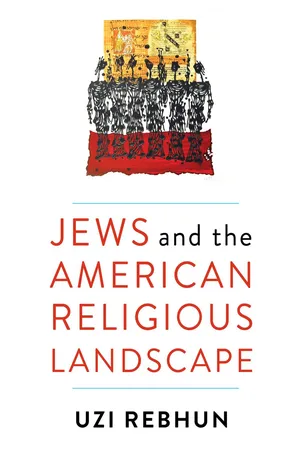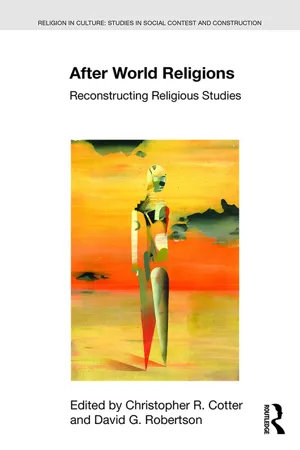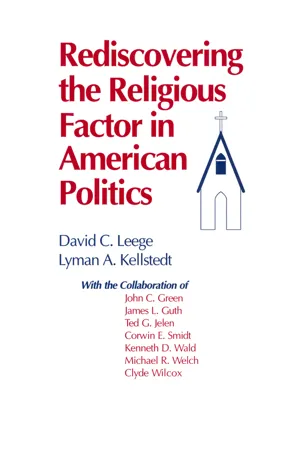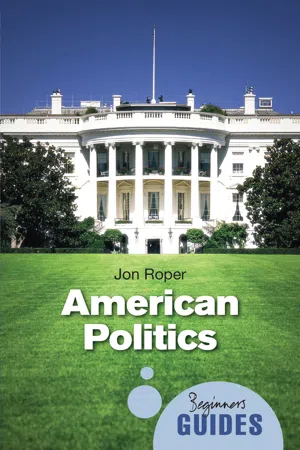History
Religion in America
Religion in America has been a significant force shaping the nation's history and culture. From the early influence of Protestantism to the diversity of religious beliefs today, religion has played a central role in shaping American identity and values. The concept of religious freedom and the separation of church and state have been key themes in the ongoing evolution of religion in America.
Written by Perlego with AI-assistance
Related key terms
8 Key excerpts on "Religion in America"
- eBook - ePub
- Uzi Rebhun(Author)
- 2016(Publication Date)
- Columbia University Press(Publisher)
INTRODUCTION Religion in AmericaR ELIGION IS central in American life for members of all social and economic strata. Even if its potency may have diminished somewhat in recent times, religion today is more diverse than ever, omnipresent in the public domain including culture and politics, pluralistic and embellished with new forms of beliefs and practices. Americans’ religious identity is dynamic. People move freely among religious styles to maximize the meaning and role of religion and spirituality in their lives. Pluralism and individualism, however, also convey the possibility of challenging religion in the name of “Americanism” and turning toward secular worldviews (Bellah et al. 1996 [1985]; Campbell and Putnam 2010; Chaves 2011; Cohen and Numbers 2013; Eck 2001; Kosmin and Lachman 1993; Putnam 2000; Wuthnow 2004).RELIGIOUS CHOICESAffiliation with a religious denomination is immensely important in the United States; it evidences a commitment to the most exalted of American values and reflects full participation in civic life (Swatos 1981). Being part of a religion means “being American”—identifying with and positioning oneself in the American social structure (Greeley 1972). Thus religion provides Americans not only with meaning but also with a sense of belonging (Carroll and Roof 1993). Often, a religious denomination connects people to the community (Swatos 1981).Americans manifest their religious preferences in a society that, notwithstanding certain challenges, honors the separation of religion and state as well as freedom of religion. Despite these characteristics, which are deeply rooted in American democracy, and despite the free market of religious alternatives, Protestantism—particularly in its modern mainline denominations—has long been the country’s most durable and leading faith (Ahlstrom 1975; Hudson 1965; Marty 1986), the one that “set[s] the terms for the religious dimensions of empire” (Marty 1970:23). The American spiritual style attributes importance to the unity of, and adherence to, the minutiae of this grand theological or philosophical system (Roof 1993). Protestant Christianity established ethical norms and values that shaped American culture in literature, the arts, the theater, and scholarship. The Protestant ethic set the tone for public institutions and personal ways of life (as in the expression “Protestant culture”; Hollinger 1997). Insofar as this brand of Protestantism developed along pluralistic lines, it largely encouraged the proliferation of Protestant groups or churches, some liberal and others conservative, that recognize each other, respect each other, and, generally speaking, uphold the fundamental of freedom of choice (Greely 1972). Catholics, Jews, and African Americans, in contrast, often faced debilitating prejudices and social discrimination (Roof and McKinney 1987). - eBook - ePub
American Civilization
An Introduction
- David Mauk, Alf Tomas Tønnessen, John Oakland(Authors)
- 2021(Publication Date)
- Routledge(Publisher)
This historical development is marked by certain features. First, there is a considerable religious diversity or pluralism (many different faiths) in the US. Second, religious activity with evangelical (conversion or salvation-based) and fundamentalist characteristics (strict maintenance of traditional orthodox beliefs) has been important at various times. Third, these factors have often created conflict within faiths, between different religions and with the larger society. Fourth, there has been an emphasis on the social aspects of religion and the provision of social welfare by many churches. Fifth, religion has been closely linked to a belief in democracy, freedom, and egalitarianism. Sixth, religious identities and membership in specific churches have often been connected to social class and ethnicity. Seventh, there is a constitutional emphasis on the separation of religion from the state and a protection of religious belief itself.Throughout American history, all or some of these features have been reflected in periodic religious movements (awakenings or revivals, which have varied in intensity and scope), religious activism, missionary work, utopian ideals and an interest in ecumenism (cooperation between different faiths). There has also been religious discrimination and intolerance, periods when American religiosity has been very low and increasing secularism.Native American religion
Native American religion has historically been characterized by a diversity of beliefs and practices among many distinctive tribes or peoples. Religious principles are passed down orally (rather than in written form) as histories, stories, allegories, and principles. While groups have their own belief systems, there are also common practices, traditions, and ceremonies (such as feasts, dances, and music). There are no unifying texts, but some spiritual stories have been transcribed and hence survived. These deal with the representation of animals, the spirit world, the land and nature to tell the creation stories of individual tribes. Such activities are conducted by shamans and medicine men, and Native American religion is based on early instruction of young people in the customs of tribal communities. - eBook - ePub
After World Religions
Reconstructing Religious Studies
- Christopher R Cotter, David G. Robertson(Authors)
- 2016(Publication Date)
- Routledge(Publisher)
America: Religions and Religion took the USA not merely as a stage for the evolution of European faiths, but rather as a social and cultural context capable of producing extra-denominational religious systems. It diminished the lineage obsession that Protestant influences on American religious history had generated, and instead took religion to be the fullest measure one can make of the forms produced by religious persons, even if those measures meant considering unconventional data. ‘From this perspective’, she insisted, ‘while many people live without Gods, nobody lives without a religion’ (9). It seemed impossible to avoid the influence of religion. After all, who could dis-orient themselves from an experience as pervasive as the USA’s civil religion or ignore the products of its media empires?This was a different kind of discourse about religion as an object for study. Fitzgerald has argued that broad definitions of religion (such as orientation) may make it impossible to distinguish religions from secular ideologies (2000). Albanese avoided this problem by looking at the legal, cultural, social, and other spheres wherein religion becomes defined and used by individuals and groups. Religion operates not merely as orientation but as a complex system to support the creation and maintenance of orientation. If one asks, ‘what is religion?’, no context has been set for the limits of answers. It begs ahistorical comparisons that ignore significant culture differences. As an alternative, this system-based definition is always qualified. Instead there are questions about how or why a specific group of people might see themselves or their concerns as religious in relation to the context in which they find themselves. While this is significantly relativistic, it offers a basis for creating references that are rooted in data demarcated by or with the subjects and less so by potential interpretative fictions. This leaves the force of comparison dependent on careful study of subjects and less reliant on the prowess of gifted scholars. The effect of Albanese’s definition is that students are left with no resort but to let subjects speak for themselves about what they find meaningful. For whom is the designation religious valuable? Is it a self-identification? If so, how is that orientating that person or group within society or history? Analytically, an interpreter’s goal is then to explain that speech and how it signifies in a given context. This mirrors Fitzgerald’s ethnographic model, but not only preserves the use of the term religion but also welcomes a diversity of methods for identifying significance from history, sociology, and other allied fields. - eBook - ePub
Religion and Politics in America
Faith, Culture, and Strategic Choices
- Allen D. Hertzke, Laura R. Olson, Kevin R. den Dulk, Robert Booth Fowler(Authors)
- 2018(Publication Date)
- Routledge(Publisher)
1 RELIGION AND POLITICAL CULTURE IN AMERICA: FROM THE HISTORICAL LEGACY TO THE PRESENT DAYOne cannot understand American politics today without knowing something about American religion. And one cannot understand either politics or religion without a sense of history, a sense of how the interplay among religion, politics, and culture has shaped the story of the United States. Since colonial days, religion has played a profound role in molding American culture, directly and indirectly, in ways that no one at the time of the founding ever could have imagined or predicted. To sort out the complex history of the relationships among religion, politics, and culture, we have organized this chapter around five themes: the Puritan temper, pluralism, the evangelical dimension, populism, and the contemporary growth of religious and spiritual individualism.THE PURITAN TEMPER
The United States was born of religious zeal. Its colonization coincided with, and was fueled by, dramatic upheavals in Europe that had been unleashed by the Protestant Reformation. The most important of these upheavals was the Puritan revolution that shook England and inspired many to immigrate to the New World. Today, the term “puritanical” connotes a narrow-minded, self-righteous rejection of anything pleasurable. But the Puritan legacy is something quite different. The Puritans bequeathed to Americans strong civic institutions, a sense of national mission, and a reformist impulse that continues to shape American society and political culture today.The Puritans earned their name from their desire to “purify” the Church of England and, more broadly, society itself in the late 1500s and early 1600s. Inspired by Calvinist Reformed theology, Puritans reacted vehemently against what they saw as laxity and corruption in Christian churches. Infused with a sense of moral urgency, Puritans threatened established political and religious elites, and they often suffered persecution as a result of their agitation. To many Puritans, America offered both an escape and a fresh start. Thus, many Puritans (along with other religious dissenters) found their way to American shores beginning in the early 1600s.1 - Paul Harvey, Edward Blum(Authors)
- 2012(Publication Date)
- Columbia University Press(Publisher)
Religion and Radical Politics: An Alternative Christian Tradition in the United States), applying these lenses to various groups (whether Catholic pacifists or post-1960s new religious movements) and time periods (first-wave modernism or the 2004 presidential election). As fine as many of these studies are, they have not adequately captured the breadth or the significance of American political religions.American religions have been expressed or represented in political spaces in multiple ways. If by “politics” we mean simply “government,” we must look to a particular constellation of legal, juridical, administrative, and institutional arrangements. Such an examination might include the theocratic rule of the early commonwealths, debates surrounding the scope of the First Amendment, the expression of religion in public education, or the continuing saga of Supreme Court jurisprudence. American religious traditions have lined up on all sides of these debates, which have continued since the constitutional era.Yet if by “politics” we mean a larger arena of public life, power, and communication, then religions could be seen to have been even more ubiquitous in American political history. This broadened understanding of politics would take in not only familiar institutions and debates but also manifestations like riots, alternative communities, interreligious conflicts, debates, and ideologies. Is politics, then, everywhere? Certainly it is in many more spaces than those customarily acknowledged, but it is not found simply in any public space or whenever conflict occurs. However, when such matters relate to the organization of social life (especially in matters of law, resources, recognition, power and discrepancies thereof, and pluralism, in addition to conventional areas), then politics emerges. For the purposes of this essay, I use the terms “religio-political” and “political religion” not to suggest that these religious expressions differ essentially from others but in the hope of capturing the cultural politics of American religions and their encounter with political powers. Political religions are shaped and expressed in specific conflicts (between competing forms of authority, for instance), in particular places (including, or perhaps especially, that which is not typically seen as religious space), and focused on issues that (like feminism or the war in Iraq) provoke American religions to become political.- David C. Leege, Lyman A. Kellstedt(Authors)
- 2016(Publication Date)
- Routledge(Publisher)
Part IWhy Study Religion in the Context of PoliticsPassage contains an image
David C. LeegeChapter 1 Religion and Politics in Theoretical PerspectiveReligion in Studies of the American Electorate
There are many reasons why social scientists should examine religion in studies of the American electorate (see Wald 1992, 7-38). Most American adults—between three-fifths and three-fourths—"belong" to churches, synagogues, or other religious assemblies. This is a much larger proportion of Americans than is attracted to any other kind of voluntary organization, whether it be unions, professional associations, neighborhood groups, alumni associations, clubs, or lodges. Depending on which survey one examines, somewhere between 82 and 93 percent of all adult Americans are willing to use some religious designation—Protestant, Catholic, Jewish, or other.Religion is not only an affinity. It is something that people act out in public and private ways. In a normal week, 29-39 percent of Americans, depending on the survey, attend religious services, and 48-89 percent, again depending on the survey, offer prayer to God; smaller proportions watch religious television and listen to religious radio.Churches inculcate beliefs and shape worldviews. They provide plausibility structures—i.e., ways of dealing with life's puzzles—and they offer social norms. They make different assumptions about the innate goodness or depravity of humankind, formulate rationales for the design and purpose of political systems, and generate expectations about the end of time and the outcomes of salvation. Some religious worldviews are world affirming, while others are world denying. Some churches and belief systems are universalistic and tolerant. Others are particularistic and shun all those who fail to follow their singular way. Some show respect and compassion to all human beings, but others see the hand of a judging God in the misfortunes of others.Churches often are contexts for the development of consciousness-of-kind. Such group identities may come from credal precepts, ritual sharing, or social exchanges. Churches usually provide many opportunities for interaction beyond worship services; most have collective instruments for governance, ministries, programs, and activities. Consciousness-of-kind may also develop through stigmatization. When others in the larger society, particularly the elites, discriminate against people because of their religious affiliations, beliefs, or practices, those stigmatized share a common bond and often interpret their religious life through metaphors of deliverance.- eBook - ePub
American Politics
A Beginner's Guide
- Jon Roper(Author)
- 2011(Publication Date)
- Oneworld Publications(Publisher)
Authoritarian governments or those based upon class structures that gave power to monarchs or aristocrats could restrict individual freedoms. In a republic, however, the people were sovereign, and they were deferential only to their own authority. Religion offered a countervailing power to supplement the constitutional system of checks and balances,preserving Americans against the potential damage caused by an excess of individual liberty. Tocqueville saw the problem: “how is it possible that society should escape destruction if the moral tie is not strengthened in proportion as the political tie is relaxed? And what can be done with a people who are their own masters if they are not submissive to the Deity?” The answer to both questions was to acknowledge the role of religion in shaping political life in America’s democratic republic. In 1836, the historian George Bancroft gave an Independence Day oration in Springfield, Massachusetts in which he argued that “the United States, eminently the land of democracy, is the most religious country on earth.” Political arguments in the United States are frequently articulated in a language combining what Tocqueville called the “spirit of religion” and the “spirit of freedom” in American life. Indeed, as Daniel Boorstin observed, there is a “mingling of political and religious thought” that he regarded as a characteristic of the peculiar and particular “genius of American politics.”The great moral causes that have impacted upon American political life have been often framed in a religious context. Before the Civil War, religious reformers were prominent among the advocates of the abolition of slavery. At the end of the nineteenth century they supported temperance and encouraged Americans toward sobriety. In 1920, the eighteenth amendment to the Constitution banned the production, sale and transportation of alcohol, although its unintended consequences might have given pause to those who believe in legal solutions to moral problems. Prohibition gave license to organized crime to supply the nation’s demand for what was now an illegal substance, and fortunes were made during the thirteen years before the amendment was repealed. - eBook - ePub
American Grace
How Religion Divides and Unites Us
- Robert D. Putnam, David E. Campbell(Authors)
- 2010(Publication Date)
- Simon & Schuster(Publisher)
CHAPTER 3
RELIGIOSITY IN AMERICA : THE HISTORICAL BACKDROP
T rinity Episcopal Church in Boston (founded 1733) and Saddleback Church in Orange County (founded 1980) stand at opposite corners of America. Although they have much in common as sites of worship and fellowship, Trinity Boston and Saddleback represent different phases in the centuries-long development of American religion. This chapter and the next aim to provide a succinct interpretive summary of Religion in America in the decades since the end of World War II.1 Writing contemporary history is hazardous, because our understanding of the past, especially the recent past, inevitably changes as the future unfolds. Peaks, valleys, and landmarks dwindle as we move forward and then reappear in a new perspective as our path winds on. Reinterpretation of the past never ceases. Nevertheless, some sense of how we got here is crucial to describing and assessing where we are today.The theme of Chapters 3 and 4 is change. Yet we begin by emphasizing that some things never change or at any rate change so slowly as to be virtually imperceptible. The most important fact about Religion in America is that we are now—and have been since the Founding—a relatively pious and observant people, as we saw in Chapter 1 . Scholars hotly debate exactly whether and how attendance at religious services has changed in the United States in recent decades, and we shall shortly join that debate, but most agree that church attendance has been relatively high in America throughout our history. Indeed, many argue that church attendance was higher in the twentieth century than in previous eras.2Closer to our focus on the postwar era, when national surveys began to provide firmer evidence about Americans’ religious beliefs and practices, one survey in 1948 found that 73 percent of Americans believed in the afterlife.3 Six tumultuous decades later our 2006 Faith Matters survey found a statistically indistinguishable 70 percent. In 1937 an early Gallup Poll reported that 73 percent of Americans were members of a church or synagogue, and as late as 1999, despite some ups and downs, that figure was still 70 percent.4
Learn about this page
Index pages curate the most relevant extracts from our library of academic textbooks. They’ve been created using an in-house natural language model (NLM), each adding context and meaning to key research topics.







